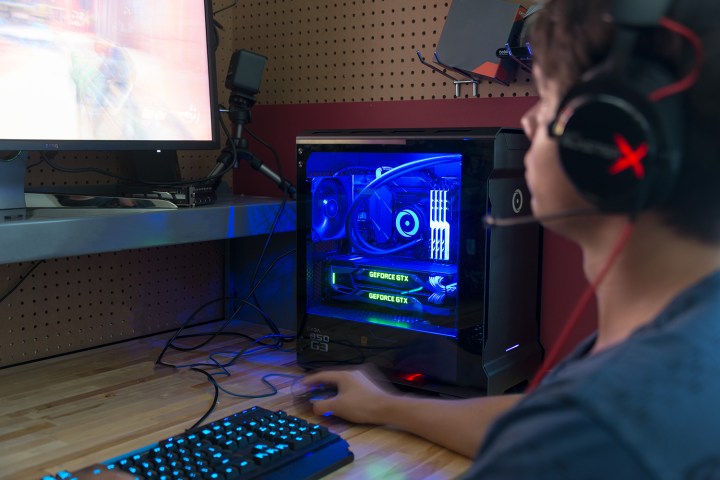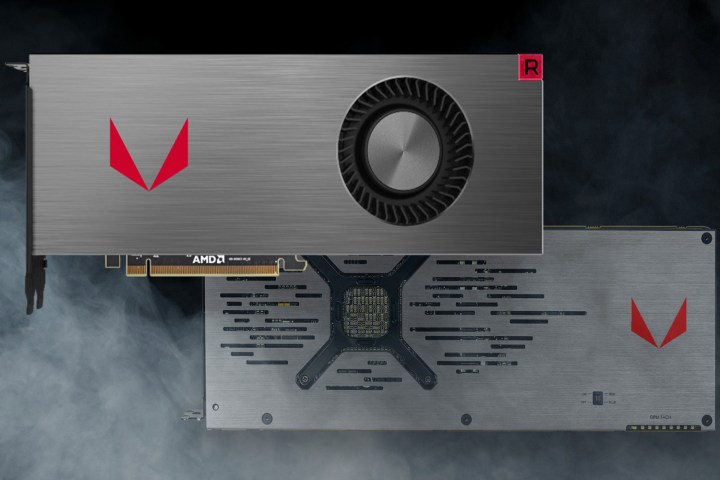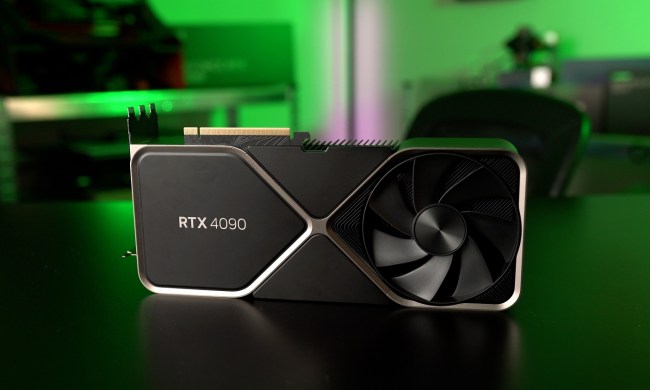
Once you have a processor and motherboard in place, the next step is to choose the best graphics card for gaming you can buy. Nvidia and AMD are the sole players in this market, and rely on third parties such as Asus, EVGA, MSI, Sapphire, and Zotac to produce add-in graphics cards. These manufacturers tend to saturate the market and make the choice a bit overwhelming.
Thus, the best attack vector is to focus on the foundation. On the Nvidia front, the company provides its GeForce GTX 10 Series cards, and actually manufactures “Founders Edition” models so you’re not investing in additional fluff third-party makers like to layer onto Nvidia’s design. AMD doesn’t do this, but instead solely creates a reference design for its partners to use and modify at will.
Everything listed in our guide below is based on Nvidia’s Founders Edition models, and AMD’s reference designs. The strategy here is to decide what best fits your needs and budget, and then investigate the third-party products based on those decision. These companies typically speed up the graphics chip, improve on the cooling design, and even rip out the fans for water-based solutions. That means you’ll see additional power requirements for third-party cards.
The Titan versus the Vega
If you want to see a heavyweight boxing match between Nvidia and AMD, this is the fight of the year. Nvidia got a head start when it released the Titan Xp earlier this year, but AMD’s Radeon RX Vega 64 came out swinging in August to regain control of the graphics card market. AMD clearly comes out on top in the performance-per-dollar battle, but at the cost of a higher power requirement. The Vega 64 also falls behind in memory bandwidth, texture fill rates, and pixel fill rates.
But note that the RX Vega 64 offers improved performance when system builders use a liquid-based cooling setup versus air-based cooling. This card also relies on “stacked” skyscraper-style on-board memory versus the city block-style GDDR5X-based memory used in Nvidia’s design. Yet despite HBM2 memory saving physical space, AMD’s card is still bigger than the Titan Xp — and that’s just based on the reference designs.
| Nvidia Titan Xp |
AMD Radeon RX Vega 64 |
|
| Architecture | Pascal | GCN 5 |
| GPU: | GP102-450 | Vega 10 XT |
| Cores: | 3,840 | 4,096 |
| Base speed: | 1,480MHz | 1,247MHz |
| Boost speed: | 1,582MHz | 1,546MHz |
| Memory: | 12GB GDDR5X | 8GB HBM2 |
| Memory speed: | 11GBps | 1.9Gbps |
| Memory interface: | 384-bit | 2,048-bit |
| Memory bandwidth: | 547GB/sec | 484GB/sec |
| Ports: | 3x DisplayPort 1.4 1x HDMI 2.0b |
3x DisplayPort 1.4 1x HDMI 2.0b |
| Dimensions: | 4.376 x 10.5 inches 2-slot height |
5.11 x 11.02 inches 2-slot height |
| Power connectors: | 1x 8-pin 1x 6-pin |
2x 8-pin |
| Power usage: | 250 watts | 295 watts |
| Interface: | PCI Express 3.0 x16 | PCI Express 3.0 x16 |
| Performance (FP32): | 12.1 TFLOPS | 12.6 TFLOPS |
| Starting price: | $1,199 | $499 |
$500 to $700: Ultra 4K gaming and beyond
Right now, Nvidia fills this price bracket with its two GTX 1080 cards. The GTX 1080 – along with the GTX 1070 – was the first card to hit the market based on Nvidia’s “Pascal” graphics chip design. Both arrived in May 2016, and were followed by the beefier GTX 1080 Ti graphics card in February 2017.
That said, the two GTX 1080-branded models are the best Nvidia-designed cards currently on the market falling under the Titan Xp’s $1,199 price point. Both can be purchased straight from Nvidia as Founders Edition models, but if you want increased speeds, different cooling options, and more, there are plenty of third-party solutions on the market.
For example, EVGA alone produces 18 cards based on the GTX 1080 TI, and 13 based on the vanilla GTX 1080 design. Zotac only sells seven GTX 1080 Ti cards, and seven GTX 1080 cards.
| Nvidia GTX 1080 Ti |
Nvidia GTX 1080 |
|
| Architecture: | Pascal | Pascal |
| GPU: | GP102-350 | GP104-400 |
| Cores: | 3,584 | 2,560 |
| Base speed: | 1,480MHz | 1,607MHz |
| Boost speed: | 1,583MHz | 1,733MHz |
| Memory: | 11GB GDDR5X | 8GB GDDR5X |
| Memory speed: | 11Gbps | 10Gbps |
| Memory interface: | 352-bit | 256-bit |
| Memory bandwidth: | 484GB/sec | 320GB/sec |
| Ports: | 3x DisplayPort 1.4 1x HDMI 2.0b |
3x DisplayPort 1.4 1x HDMI 2.0b 1x DL-DVI |
| Dimensions: | 4.376 x 10.5 inches 2-slot height |
4.376 x 10.5 inches 2-slot height |
| Power connectors: | 1x 8-pin 1x 6-pin |
1x 8-pin |
| Power usage: | 250 watts | 180 watts |
| Interface: | PCI Express 3.0 x16 | PCI Express 3.0 x16 |
| Performance (FP32): | 11.3 TFLOPS | 8.9 TFLOPS |
| Starting price: | $699 | $549 |
$400 to $500: QHD to Ultra 4K gaming
To be honest, you can purchase the latest gaming console for the cost of one of the graphics cards listed in this price bracket (well, almost). In this batch, we have Nvidia’s two GTX 1070 cards, one of which just launched at the beginning of November (the 1070 Ti). Their biggest opponent is AMD’s recently-released Radeon RX Vega 56 graphics card, which targets the GTX 1070 Ti more than it does the vanilla GTX 1070.
For this group, AMD’s card provides a wider memory bandwidth, but requires more power. And despite the Vega 64 having 3,584 cores, they’re only speeding along at a maximum 1,471MHz versus the lower core count with higher speeds in the two GTX 1070 cards. All three should do fairly well pumping out high framerates at an Ultra HD resolution although the vanilla GTX 1070 may feel less stressed when rendering your games at a QHD setting.
| Nvidia GTX 1070 Ti |
Nvidia GTX 1070 |
AMD Radeon RX Vega 56 |
|
| Architecture | Pascal | Pascal | GCN 5 |
| GPU: | GP104-300 | GP104-200 | Vega 10 XL |
| Cores: | 2,432 | 1,920 | 3,584 |
| Base speed: | 1,607MHz | 1,506MHz | 1,156MHz |
| Boost speed: | 1,683MHz | 1,683MHz | 1,471MHz |
| Memory: | 8GB GDDR5 | 8GB GDDR5 | 8GB HBM2 |
| Memory speed: | 8Gbps | 8Gbps | 1.6Gbps |
| Memory interface: | 256-bit | 256-bit | 2,048-bit |
| Memory bandwidth: | 256GB/sec | 256GB/sec | 409GB/sec |
| Ports: | 3x DisplayPort 1.4 1x HDMI 2.0b 1x DL-DVI |
3x DisplayPort 1.4 1x HDMI 2.0b 1x DL-DVI |
3x DisplayPort 1.4 1x HDMI 2.0b |
| Dimensions: | 4.376 x 10.5 inches 2-slot height |
4.376 x 10.5 inches 2-slot height |
5.11 x 11.02 inches 2-slot height |
| Power connectors: | 1x 8-pin | 1x 8-pin | 1x 8-pin 1x 6-pin |
| Power usage: | 180 watts | 150 watts | 210 watts |
| Interface: | PCI Express 3.0 x16 | PCI Express 3.0 x16 | PCI Express 3.0 x16 |
| Performance: | 7.8 TFLOPS | 6.5 TFLOPS | 10.5 TFLOPS |
| Starting price: | $449 | $399 | $399 |
$150 to $400: FHD to QHD gaming
This bracket is a bit more crowded due to Nvidia’s two GTX 1060 designs. One provides 6GB of on-board memory and 1,280 cores whereas the other only has 3GB of memory and a lower core count. Meanwhile, the upper end of AMD’s Radeon RX 500 series introduced earlier this year targets both GTX 1060 models and includes two variants of the company’s RX 580 design (8GB and 4GB).
In the case of AMD, the RX 500 Series is based on the company’s older GCN 4 “Polaris” design first introduced in 2016. AMD originally released its Radeon RX 400 series last year using this design, but then tweaked Polaris and issued the 500 Series earlier this year. The target: affordable graphics for the mainstream desktop market supporting high-resolution games, and high-quality virtual reality.
| Nvidia GTX 1060 6GB |
Nvidia GTX 1060 3GB |
AMD Radeon RX 580 |
AMD Radeon RX 570 |
|
| Architecture: | Pascal | Pascal | GCN 4 | GCN 4 |
| GPU: | GP106-400 | GP104-140 | Polaris 20 XT | Polaris 20 XL |
| Cores: | 1,280 | 1,152 | 2,304 | 2,048 |
| Base speed: | 1,506MHz | 1,506MHz | 1,256MHz | 1,168MHz |
| Boost speed: | 1,708MHz | 1,708MHz | 1,340MHz | 1,244MHz |
| Memory: | 6GB GDDR5 | 3GB GDDR5 | 4GB / 8GB GDDR5 | 4GB GDDR5 |
| Memory speed: | 8Gbps | 8Gbps | 8Gbps | 7Gbps |
| Memory interface: | 192-bit | 192-bit | 256-bit | 256-bit |
| Memory bandwidth: | 192GB/sec | 192GB/sec | 256GB/s | 224GB/sec |
| Ports: | 3x DisplayPort 1.4 1x HDMI 2.0b 1x DL-DVI |
3x DisplayPort 1.4 1x HDMI 2.0b 1x DL-DVI |
3x DisplayPort 1.4 1x HDMI 2.0b |
3x DisplayPort 1.4 1x HDMI 2.0b |
| Dimensions: | 4.378 x 9.823 inches 2-slot height |
4.378 x 9.823 inches 2-slot height |
2-slot height | 2-slot height |
| Power connectors: | 1x 6-pin | 1x 6-pin | 1x 8-pin | 1x 8-pin |
| Power usage: | 120 watts | 120 watts | 185 watts | 150 watts |
| Interface: | PCI Express 3.0 x16 | PCI Express 3.0 x16 | PCI Express 3.0 x16 | PCI Express 3.0 x16 |
| Performance: | 4.4 TFLOPS | 4.0 TFLOPS | 6.2 TFLOPS | 5.1 TFLOPS |
| Starting price: | $299 | $249 | $199 / $229 | $169 |
$80 to $150: eSports gaming
Finally, we enter budget territory. As the specifications reveal in the chart below, the processor core counts are low, thus these cards mostly don’t require an additional connection to your desktop’s power supply. But note that you still may see solutions from third-party makers requiring an additional 6-pin or 8-pin connection to handle overclocked speeds, and/or additional cooling features.
Both Nvidia and AMD are targeting the mainstream market wanting decent graphics in their PC games. More specifically, these cards are ideal for eSports players who require high frame rates, but don’t want to sacrifice graphical quality. These cards are a huge bump up from integrated graphics, but don’t expect the level of quality produced by solutions listed in the higher price brackets.
| Nvidia GTX 1050 Ti |
Nvidia GTX 1050 |
AMD Radeon RX 560 |
AMD Radeon RX 550 |
|
| Architecture: | Pascal | Pascal | GCN 4 | GCN 4 |
| GPU: | GP107-400 | GP107-300 | Polaris 21 XT | Lexa Pro |
| Cores: | 768 | 640 | 1,024 | 512 |
| Base speed: | 1,290MHz | 1,354MHz | 1,175MHz | 1,100MHz |
| Boost speed: | 1,392MHz | 1,455MHz | 1,275MHz | 1,183MHz |
| Memory: | 4GB GDDR5 | 2GB GDDR5 | 2GB GDDR5 | 2GB GDDR5 |
| Memory speed: | 7Gbps | 7Gbps | 7Gbps | 7Gbps |
| Memory interface: | 128-bit | 128-bit | 128-bit | 128-bit |
| Memory bandwidth: | 112GB/sec | 112GB/sec | 112GB/sec | 112GB/sec |
| Ports: | 1x DisplayPort 1.4 1x HDMI 2.0b 1x DL-DVI |
1x DisplayPort 1.4 1x HDMI 2.0b 1x DL-DVI |
1x DisplayPort 1.4 1x HDMI 2.0b 1x DL-DVI |
1x DisplayPort 1.4 1x HDMI 2.0b 1x DL-DVI |
| Dimensions: | 4.38 x 5.7 inches 2-slot height |
4.38 x 5.7 inches 2-slot height |
2-slot height | 2-slot height |
| Power connectors: | N/A | N/A | 1x 6-pin | 1x 6-pin |
| Power usage: | 75 watts | 75 watts | 80 watts | 50 watts |
| Interface: | PCI Express 3.0 x16 | PCI Express 3.0 x16 | PCI Express 3.0 x8 | PCI Express 3.0 x8 |
| Performance: | 2.1 TFLOPS | 1.8 TFLOPS | 2.6 TFLOPS | 1.2 TFLOPS |
| Starting price: | $139 | $109 | $99 | $79 |








